

100 Years of Breed “Improvement” For the sake of honest disclosure, I will admit to owning “purebreds” (the ‘pureness’ of purebreeds is a discussion for another time) but I also have mutts.
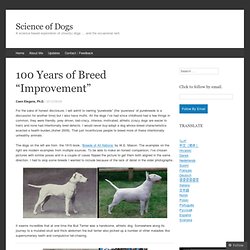
All the dogs I’ve had since childhood had a few things in common, they were friendly, prey driven, ball-crazy, intense, motivated, athletic (crazy dogs are easier to train) and none had intentionally bred defects. I would never buy/adopt a dog whose breed characteristics exacted a health burden. How Dogs Know What You're Feeling. When you hear a friend’s voice, you immediately picture her, even if you can’t see her.
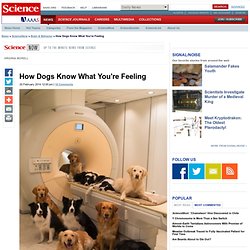
And from the tone of her speech, you quickly gauge if she’s happy or sad. You can do all of this because your human brain has a “voice area.” Now, scientists using brain scanners and a crew of eager dogs have discovered that dog brains, too, have dedicated voice areas. The finding helps explain how canines can be so attuned to their owners’ feelings. Wolf to Dog - Scientists Agree on How, but Not Where. What spectrum of color do dogs see? — by Roger Abrantes When training dogs in any scent detection discipline, we should use colors that are difficult for them to see so to compel them to use their noses (and not their eyes) to find the target (picture from Joy of Living).

Do dogs see colors? Does that affect our dog training in any way? These are the questions I will answer today. In the early 1980s, we performed some tests at the Ethology Institute Cambridge to determine whether dogs were color-bind as the popular view says. Eyes contain light catching cells (cones) that respond to color. Researchers at the University of California in Santa Barbara tested in the late 1980s the color vision of dogs.
Studies performed by Russian scientists demonstrated that dogs tend to discriminate real color rather than brightness cues. Trichromats, like most humans, have three color-detecting cones (blue, green and red) and can distinguish between 100 different gradations of color. Human = A and C. References Kasparson, A. et al. 2013. Dogs That Changed the World: Rise of the Dog. Birthplace of Dogs Discovered. The time-tested bond between humans and dogs is well-documented, but researchers have puzzled for a long time over where and when our species became so interlocked.

Previous studies indicated East Asia as the site where wolves were first tamed, but a new study delves even deeper and reveals even more history of man's best friend. From Science Daily, These discoveries are presented in an article in the scientific journal Molecular Biology and Evolution, where it is claimed that the dog appeared 16,000 years ago, in Asia, south of the Yangtze River in China. This is a considerably more specific date and birthplace than had previously been put forward. According to the researchers, taming wolves to work with humans occurred at roughly the same time as people in this part of the world transitioned from hunters and gatherers to farmers. Unfortunately, it appears that the bond between man and wolf/dog was still a bit tenuous.
Source: Science Daily. DNA Backs Lore on Pre-Columbian Dogs. John W.
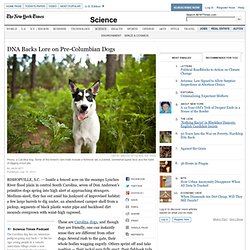
Adkisson for The New York Times Peony, a Carolina dog. Some of the breed’s rare traits include a fishhook tail, a pointed, somewhat lupine face and the habit of digging snout pits. These are Carolina dogs, and though they are friendly, one can instantly sense they are different from other dogs. Several rush to the gate, their whole bodies wagging eagerly. Walking into the pen is dangerous for only one reason: one of the dogs’ defining habits is digging snout pits, or gallon-size holes in the ground, perhaps to root for grubs or munch the soil for nutrients. “It’s like a lunar landscape,” Mr. Modern dog breeds genetically disconnected from ancient ancestors.
Cross-breeding of dogs over thousands of years has made it extremely difficult to trace the ancient genetic roots of today's pets, according to a new study led by Durham University.
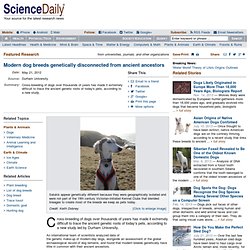
An international team of scientists analyzed data of the genetic make-up of modern-day dogs, alongside an assessment of the global archaeological record of dog remains, and found that modern breeds genetically have little in common with their ancient ancestors. Dogs were the first domesticated animals and the researchers say their findings will ultimately lead to greater understanding of dogs' origins and the development of early human civilization. Although many modern breeds look like those depicted in ancient texts or in Egyptian pyramids, cross-breeding across thousands of years has meant that it is not accurate to label any modern breeds as "ancient," the researchers said. The dingo is originally from southern China. THE DINGO (Canis lupus dingo) first appeared in Australia's archaeological records in 3500-year-old rock paintings in the Pilbara region of WA, but the new evidence suggests they were roaming Australia long before that.

DNA samples from domestic Asian dog species and the Australian dingo have shed light on how the iconic canine arrived on Australian soil. According to a study by an international research team, genetic data shows the dingo may have originated in southern China, travelling through mainland southeast Asia and Indonesia to reach its destination anywhere between 4600 and 18,300 years ago. Dingo theory debunked. Do Dogs Speak Human? What's the Big Idea?
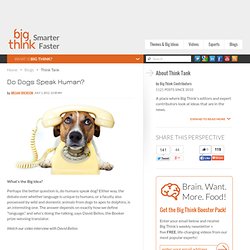
Perhaps the better question is, do humans speak dog? Either way, the debate over whether language is unique to humans, or a faculty also possessed by wild and domestic animals from dogs to apes to dolphins, is an interesting one.